Coins of famous European rulers
In alphabetical order
Oliver Cromwell
Lord Protector of England, Scotland, and Ireland, 1653-8 AD.
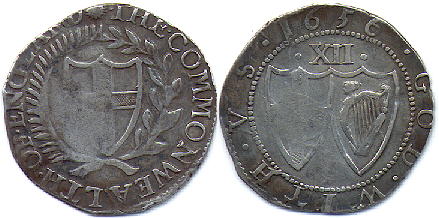
Silver Shilling, 30 mm, 1656 AD
Obverse: St. George's cross within wreath, "THE COMMONWEALTH
OF ENGLAND", sun mintmark.
Reverse: St. George's cross, Irish harp, "GOD WITH US, 1656"
The coins struck during the Commonwealth have inscriptions in English,
in keeping with Puritan values, rather than the Latin that had become customary
on coinage, as Latin was considered too Papal. St. George's cross
and the Irish harp take the place of the royal arms.
Oliver Cromwell, the inspiring military leader who led the Parliamentary forces to victory in the English Civil War, is the man most responsible for the eventual establishment of parliamentary democracy as the English form of government.
In 1628, Cromwell was elected to Parliament, but served only briefly, as the following year King Charles I decided to dismiss Parliament and govern alone. In 1640, in need of money to pursue war against the Scots, Charles called a new Parliament. This Parliament, of which Cromwell was also a member, demanded assurances against resumption of arbitrary rule by the King. Charles I was unwilling to be subservient to Parliament, and war broke out in 1642 between forces loyal to the King and those loyal to Parliament.
During the war, Cromwell distinguished himself as the most successful general on the Parliamentary side. The war ended in 1646 with Charles as a prisoner. After Charles escaped and attempted to rally his forces, he was recaptured and executed in 1649.
Meanwhile, repeated rounds of hostilities, as well as social and religious conflicts, had had severe effects on the Parliamentary forces, with elimination of the more moderate elements. England had now become a republic (called the Commonwealth), with Cromwell as chairman of the Council of State. However, all that remained of Parliament was a small, unrepresentative, extremist minority, the so-called "Rump". Cromwell was unsuccessful in his attempt to call for new elections, and dissolved the Rump by force (1653).
From 1653 until his death from malaria in 1658, Cromwell ruled as a military dictator, under the title Lord Protector. However, his repeated attempts to institute democratic practices, as well as his refusal of the throne when it was offered to him, indicate that dictatorship was not what he sought; it was forced upon him by the inability of his supporters to establish a workable government. During Cromwell's tenure, he ameliorated harsh laws, and supported education. An ardent Puritan, he believed in religious toleration, and permitted the Jews to resettle in England.
Though the English Commonwealth failed soon after Cromwell's death, the monarchs that followed had lost considerable power to Parliament. The end result, a constitutional monarchy with the king subservient to Parliament, was what Cromwell had wanted in 1640.
Eleanor of Aquitaine
Born 1122 AD, Died 1204 AD
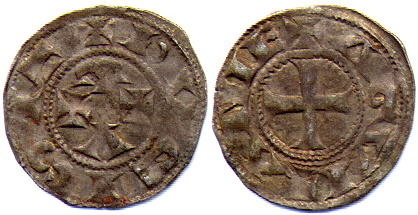
Silver Denier, 18 mm
O: legend around AW and two cross
R: legend around cross
Aquitaine mint, struck 1137-1169.
Eleanor of Aquitaine, renowned for her cultivated intelligence and
great beauty, was queen to two kings and mother of two others, and a patroness
of courtly literature.
Heiress of the duchy of Aquitaine, she married King Louis VII of France in 1137, and accompanied him on the Second Crusade. During that crusade, her actions caused him to doubt her fidelity, and he annulled their marriage in 1152. Soon after, she married Henry of Anjou, who became King Henry II of England (1154-1189). After supporting her sons in an unsuccessful revolt against their father, she spent most of the time from 1173 to 1189 locked in a tower. After Henry's death in 1189, she became a dominant figure in English politics during the reign of her son, Richard I the Lion-Hearted (1189-1199). After Richard's death in battle, she supported the succession of her youngest son, John (1199-1216), before returning to her native Aquitaine at the end of her life.
Elizabeth I
Queen of England, 1558-1603 AD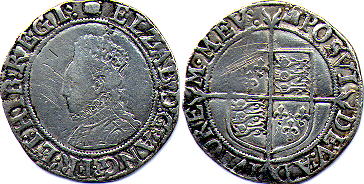
Silver Shilling (12 pence), 31 mm.
Obverse: Portrait of Elizabeth, facing left. Legend, in Latin with extensive abbreviation, "Elizabeth, by the grace of God, Queen of England, France and Ireland." Woolpack mintmark above.
Reverse: Royal shield over long cross. Latin legend: "I have made God my helper."
The woolpack mintmark indicates that the coin was struck 1594-1596 A.D.
Elizabeth I was the daughter of Henry VIII and his second wife Anne Boleyn, who was executed in 1536 AD on suspicion of infidelity. Elizabeth grew up without a mother's care. On the death of her half-brother, Edward VI, she sided with her Catholic half-sister, Mary I. Despite this fact, Mary, suspicious of Elizabeth's identification with protestantism, had her imprisoned for her alleged part in a rebellion led by Sir Thomas Wyatt.
Ascending to the throne on Mary's death in 1558, Elizabeth reduced animosities and promoted stability by engineering a moderate Protestant Church settlement, effectively establishing a distinctive Anglican church.
Although Elizabeth never married, she had many suitors. She was greatly attracted to Robert Dudley, earl of Leicester, and might have wed him had he not been suspected (probably incorrectly) of murdering his wife. Elizabeth rejected an offer of marriage from the Spanish king, Philip II, but she did allow lengthy courtships by two members of the French royal family, the future King Henry III of France, and his brother Francois. She prided herself on the fact that she lived and died a virgin -- the colony Virginia was named for her -- and she turned her single state to diplomatic advantage, keeping foreign suitors dangling for years.
Politics was inseparable from religion, and Elizabeth withstood many threats, originating both at home and abroad, from Catholics intent on regaining Catholic control of the throne. Perhaps the gravest threat to Elizabeth came in 1588 from Philip II of Spain, who sent his "Invincible Armada." England managed to repel the attack, aided by a "Protestant wind", but war continued to 1604.
Elizabeth was popular with her subjects, and her reign is seen as a period of generally effective government, cultural development, and increased international status.
Gustav II Adolph (Gustavus Adolphus)
King of Sweden, 1611 - 1632 AD
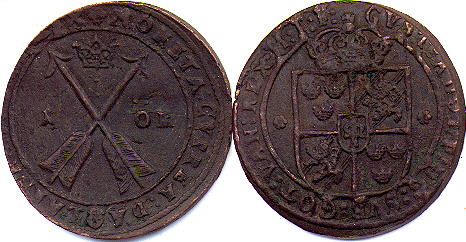
Copper 1 Ore, 40 mm, 1629 AD
Obverse: Crossed Arrows. Reverse: Crown atop coat of arms.
The economic pressures of the Thirty Year's War encouraged Gustav to
begin minting large coins in copper.
Gustav II Adolph is considered the greatest Swedish king. He is renowned for his brilliant leadership of the Protestant forces in the Thirty Years' War, and became known as the Lion of the North.
Gustav waged successful wars against Russia and Poland, with resulting significant territorial gains.
A religious interest in the Protestant cause and a belief that conquest of northern Germany by the Holy Roman Empire would be militarily and economically dangerous to Sweden impelled Gustav to enter the Thirty Years' War. His brave leadership led to important Protestant victories. Though victorious, he was fatally wounded at the Battle of Lützen in Saxony in 1632.
Gustav was not only a great general but a capable administrator. He developed a sound and centralized system of government and did much to develop the natural mineral resources of his country. He was succeeded by his daughter, Christina.
Henry VIII, King of England
Born 1491 A.D., King 1509-1547 A.D.
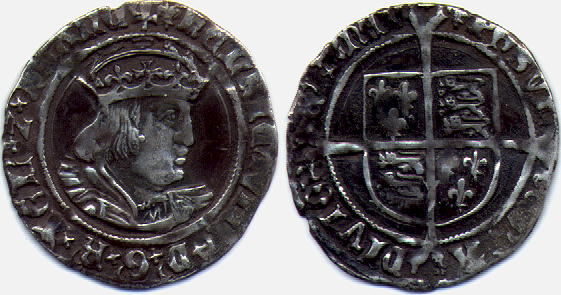
Silver Groat (Fourpence), 25 mm
O: Crowned bust of Henry VIII facing right.
R: Tudor coat of arms.
Struck between 1526 and 1544 AD, London mint.
Henry VIII, king of England from 1509 to 1547, instigated the reformation of the English church in order to secure a divorce from the first of his six wives. Shortly before he took the throne, Henry VIII married Catherine of Aragon, who was the widow of his brother, Arthur. He sought a divorce because he believed that her failure to produce a male heir was a sign that God was displeased with his union with his dead brother's wife, and/or because he had fallen in love with Anne Boleyn. When Pope Clement VII could not or would not grant the request for a divorce, events began that led to the establishment of the Church of England as an independent national church, no longer in communion with the Roman Catholic church or the pope. Henry VIII eventually had six wives, whose fates are summarized as follows:
"divorced, beheaded, died,
divorced, beheaded, survived."
Ivan IV, the Terrible
Born 1530 A.D., Tzar, 1547-1584 A.D. 
Silver Denga, 11 by 10 mm.
O: Ivan on horseback.
R: Inscription.
Struck by Ivan IV as "Great Prince", 1533-1547 A.D.
Ivan IV, known as "Ivan the Terrible" was the first Russian ruler to be crowned tzar and to hold that official title. He centralized the administration of Russia and expanded the boundaries of the Russian empire. The first part of Ivan's reign is considered the "constructive period", with advances in Russian territories and trade, government reforms, new law codes, and delineation of the responsibilities of the aristocracy. Following the death of his first wife, in 1560, he withdrew from Moscow and threatened to abdicate, blaming his advisors and the aristocracy for her death. He agreed to return when given substantially increased powers. He used those powers to exact a terrible revenge on the aristocracy.
Vladimir Ilich Lenin
Russian Revolutionary, Founder of the Communist party, and first head of state of the USSR, d. 1924 A.D.
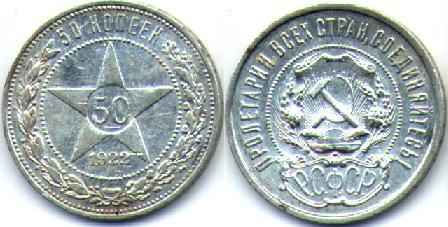
Russian Socialist Federal Soviet Republic
Silver 50 Kopeks, 1922 AD, 27 mm, 10 grams
Petrograd mint (since renamed Leningrad in 1924, and St. Petersburg
in 1991)
Born Vladimir Ilich Ulyanov in 1870, he adopted the pseudonym "Lenin" early in his career. He was the founder of the Russian Communist party, leader of the Bolshevik Revolution of 1917, and first head of state of the USSR. He was also a masterly political thinker whose theories became a significant component of Communist thought and influenced all factions of the Marxist movement.
Mary, Queen of Scots
Born 1542 AD, Queen of Scotland 1542-1567 AD, Died 1587 A.D.

Billon (low-grade silver) Bawbee
Obverse: Crowned thistle dividing M R
Reverse: St. Andrews cross crowned in center
Mint of Edinburgh, 1542-1548 AD
Mary Stuart was born in 1542, the daughter of James V, King of Scotland
and Mary of Guise (of the French royal family). Six days after her birth
her father died, and she became queen of Scotland. From her infancy,
Scotland's rival pro-English and pro-French factions plotted to gain control
of Mary and Scotland.
To add further complication and intrigue, many Roman Catholics recognized Mary as Queen of England after the Protestant Elizabeth I succeeded to the throne. Mary was granddaughter of Margaret Tudor, sister of Henry VIII. To the Roman Catholics, Mary's claim appeared stronger than Elizabeth's because they viewed Henry's marriage to Anne Boleyn as illegal.
Mary spent her early years in France as part of the French royal family. In April 1558 she married the dauphin, Francis; she secretly agreed to bequeath Scotland to France if she should die without a son. In July 1559, Francis succeeded his father, becoming King Francis II, and Mary became queen of France as well as of Scotland. However, Francis died after a reign of 17 months. Soon after, in 1561, Mary decided to return to Scotland.
Upon her arrival in Scotland, she was caught up in intrigue between Protestant reformers and Roman Catholics. Subsequent events were highly complex and not entirely known, and defy any kind of brief summary. Suffice it to say that events involved a marriage to her cousin which angered the Protestants, the souring of her marriage, the murder (in her presence) by the Protestants and her husband of her trusted advisor, the murder of her husband (probably without but possibly with Mary's knowledge), and the subsequent marriage by Protestant rite of Mary to one of the suspects in her former husband's murder.
In 1567, nobles opposed to Mary and her new husband imprisoned her and forced her to abdicate in favor of her son, James VI of Scotland (later James I of England).
Mary escaped from prison and, in 1568, lost in battle to the Protestants. She fled to England to beg support from her cousin, Elizabeth. Always a threat to Elizabeth because she was a magnet for plots by Catholics to regain the throne, Mary was imprisoned in England for 19 years and eventually beheaded.
Nicholas II
Tzar of Russia, 1894-1917 AD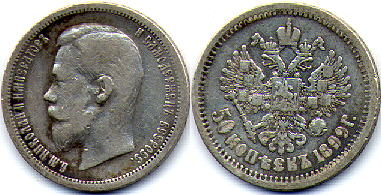
Silver 50 Kopeks, 27 mm.
Dated 1899 A.D.
St. Petersburg mint
Nicholas II was the last emperor of Russia. The eldest son of Alexander III, Nicholas succeeded his father with the intention of continuing his autocratic rule but lacked Alexander's ability and strength of will. He wavered between severe repression and, in time of popular upheaval, grudging acceptance of limited reforms that he sought to withdraw after the turmoil subsided. Nicholas was a passive man and allowed Alexandra, his superstitious and strong-willed wife, and her insidious advisor, Rasputin, great sway over government policy.
Disastrous defeats in the Russo-Japanese War (1904-05) exposed the incompetence and corruption of the government. and precipitated the Russian Revolution of 1905. Nicholas promised a constitutional government with a representative Duma authorized to approve or reject all proposed laws. After revolutionary activity ebbed, however, Nicholas dissolved the first two Dumas when they showed an independent spirit, and subsequently reduced the Duma's role to that of an advisory body.
World War I proved to be Nicholas' undoing. In 1915 he took personal command of the army, giving Alexandra and Rasputin greater power at the court. Rumors of their unsavory activities, along with Russia's deteriorating military and economic situation, eroded public morale. Strikes and riots erupted in the capital and Nicholas abdicated at the Duma's demand. Exiled to western Siberia and later the Urals region, he and his family were executed by the Bolsheviks on the night of July 16-17, 1918.
